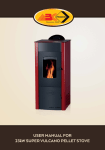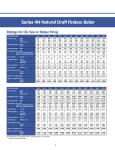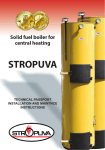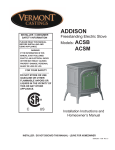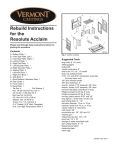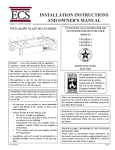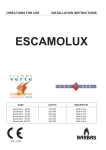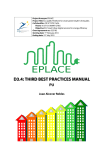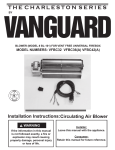Download Lily TU Engleska.cdr
Transcript
USER MANUAL 9kW LILLY PELLET STOVE Table of Contents 1.Overview of Stove Parts .....................................................................1 2.Technical Characteristics .................................................................. 3 3.Important Information ........................................................................ 4 4.Pellet Specification ............................................................................5 5.Technology ....................................................................................... 6 6.Installation ........................................................................................ 6 7.Function Operations .......................................................................... 8 8. User Menu ......................................................................................10 9.Maintenance and Cleaning ..............................................................12 10. Environmental Protection ............................................................. 15 11. Appendix ...................................................................................... 16 ABC PROIZVOD D.O.O. Miloša Obrenovića 2 31000 Užice telefoni: +381 (0)31 514 501. 514 502 e-mail: offi[email protected] 1. OVERVIEW OF STOVE PARTS 1 1.1 Description of Stove Parts NO. DESCRIPTION PCS 1 Firebox sheets 1 2 Interior firebox sheets 1 3 Pedestal 1 4 Pellet inserter 1 5 Encased spiral 1 6 Air injection device 1 7 Assembly of sheets behind the firebox 1 8 Hoper 1 9 Top firebox outlet 1 10 Bottom firebox outlet 1 11 Top burner outlet 1 12 Top outlet 1 13 Ribbed outlet 1 14 Stove door 1 15 Burner holder 1 16 Burner 1 17 Front vermiculite plate “left” 1 18 Back vermiculite plate “left” 1 19 Front vermiculite plate “right” 1 20 Front vermiculite plate “left” 1 21 Lilly Fan 1 22 Heater 1 23 Electronic board 1 24 Right sheeting 1 25 Right sheeting 1 26 Top sheeting case 1 27 Bottom sheeting case 1 28 Sheeting cover 1 29 Back sheeting 1 30 Gear case 1 31 Stove controller 1 32 Ash trap 1 2 2.TECHNICAL CHARACTERISTICS Characteristics Value Efficiency ratio (%) 90,1 Weight (kg) 115 Height (mm) 1080 Width (mm) 500 Depth (mm) 630 Min-max stove power (kW) 2,4 - 9 Required draught (Pa) 3 Hoper capacity (kg) 25 Operation autonomy (max-min) 50h - 13h Pellet Characteristics Thermal power (kWh/kg) 4,5 - 5 Length (mm) 10 - 30 Diameter (mm) 6 Humidity (%) 6,6 Ash (%) Specific weight (kg/dm 1 3) 1,0 Flue pipe diameter (mm) 100 Pellet consumption (min-max) 0,5 - 1,8 kg/h Electricity consumption Ignition phase (W) 360 Operation phase (W) 60 220/230 (50) Power supply (vol - Hz) 3 3.IMPORTANT INFORMATION General Warnings and Safety Information § Read the entire manual before putting the stove into operation. § Only adequate means of transportation with the confirmed load capacity may be used to transport the product. § Fuel combustion results in extensive heating of the external stove surfaces (door, glass, side walls, flue pipe, etc.). Do not touch the specified parts without using the adequate personal protective equipment. § Warn children of dangers and keep them away from the operating stove. § Do not dry clothes on the stove. § Do not use highly flammable and explosive materials in the same room when the stove is operating. § When operating, the stove must be connected to the mains voltage (230V). Should unexpected power failures occur, install the UPS that will provide voltage for undisturbed stove shutdown and prevent smoke from entering the room Danger to health and life of people in the room unless the UPS is provided WARNING !!! § For safety reasons, do not open the stove doors when operating. § When loading pellets take care that the pellet does not fall into the stove parts under high temperatures. Otherwise, pellet will start to burn and smoke will appear in the room. § It is recommended to load the stove when it is completely cooled. 4 4.PELLET SPECIFICATIONS What is pellet? The wooden pellet is standardized fuel. Every manufacturer must comply with certain rules in order to provide highly energy efficient heating. Please check with your local dealer for the list of manufacturers of attested pellets. The use of poor quality pellets may have a negative impact on the stove operation. The recommended standards for pellet quality are: ÖNORM, DIN Plus or ENplus-A1 Specification of wooden pellets in accordance with En plus – A1 Parameter Unit of measurement Enplus-A1 Diameter mm 6 Length mm 3,15 do 40 Bulk density kg/m3 600 Calorific value MJ/kg 16,5 Water content Max % 10 Ash residue Max % 0,7 Chlorine content Max % 0,02 Sulphur content Max % 0,03 Nitrogen content Max % 0,3 Copper content mg/kg 10 Chromium content mg/kg 10 Arsenic content mg/kg 1 Cadmium content mg/kg 0,5 Mercury conten mg/kg 0,1 Lead content mg/kg 10 Nickel content mg/kg 10 Zinc content mg/kg 100 5 Storage of Pellets It is very important that the pellets are stored at the dry place. It is not advisable to store pellets in bags exposed to atmospheric conditions. Too wet pellets may block the auger 5.TECHNOLOGY Your new stove is technologically enhanced as a result of years of testing and top quality built-in components. The practical advantages of the Lilly stove are as follows: § Electronic monitoring of all devices along with monitoring of combustion temperature in the firebox guarantees the optimum operation of stove in all phases. § The large heat exchanger surface with the unique control of combustion air results in low consumption of pellets and high energy efficiency. § Precisely weighed pellet loading to the burner made of special cast iron leads to perfect combustion resulting in low emission of hazardous substances into atmosphere. § The top quality cast parts such as burner resistant up to 1300 and doors ensure long and safe operation. 6.INSTALLATION § Remove all accessories from the stove (user manual, power cable, § § § § § § remote controller, etc.). The stove must be connected to the chimney the minimum diameter of which is 120mm. The combustion air circulation is based on the negative pressure in the firebox and very low overpressure in the flue pipe. The flue pipes must fit the diameter of outlet pipes and no leaks shall be detected at joints. Make sure that the horizontal length of the flue pipe does not exceed 1.5m. Do not install too many elbows (direction changes of flue gases) on flue pipes. The maximum number of elbows shall be 3. Be sure to leave the room for easy dismantling of the flue pipe and easy access to the opening for cleaning. The stove must be installed on the fire-proof surface. Should the surface be flammable (wood, carpet, etc.), it is recommended to set a fireproof basis (glass, metal, ceramic tiles, etc.) 6 6.1 Electrical Connection § The stove is equipped with the power supply cable that needs to be connected to the mains 230V/50Hz § The average power consumption is ± 20W during operation and 300 W in the ignition phase for about 10 minutes. § The power cable must be laid so to avoid contact with the hot stove surfaces. 6.2 Combustion Air Every combustion process requires oxygen or air. The air taken from the room must be compensated. The loss of oxygen may occur in modern houses with high insulation efficiency and perfectly sealed windows and doors. Unless the stove is connected to fresh air intake, the room in which the stove is installed must be more frequently ventilated. 6.3 Supply of fresh air for combustion § The stove structure has a connection on the back side § The fresh air supply pipes may be made of steel or aluminium. The minimum diameter amounts to 50 mm. § The maximum pipe length shall not exceed 4 m in order to ensure adequate supply of fresh air. The pipes must not have too many elbows. § A failure to provide some of the specified conditions may result in poor combustion and vacuum generation in a room Safety distances from the stove § The distance between the flammable objects and front part of the stove must be up to 800mm, while the distance between the stove side walls and flammable objects must be up to 200mm § The distance between the non-flammable objects and front part of the stove must be up to 400mm, while the distance between the stove side walls and non-flammable objects must be up to 100mm 7 7.FUNCTION OPERATIONS 7.1 Control Panel: Functions and Use P1 P2 CHRONO DATE AND TIME L1 L2 L3 ALARM L10 L11 P3 P4 PELLET POWER Buttons Buttons Led lampice Function Light Function P1 ON-OFF / alarm reset / exit from the menu L1 Heater on P2 Menu / data storage / chrono option activation L2 Motor reducer on P3 Visualisation / increased parameter values L3 Not in function P4 Visualisation / decreased parameter values L10 L11 8 Lack of pellet (not in function) Room temperature achieved 7.2 Alarms System condition Alarm Number Safety thermostat Blocked Er 01 Safety Pressure Switch Blocked Er 02 Shutting down due to the low temperature of exhaust gases Blocked Er 03 Shutting down due to the high temperature of exhaust gases Blocked Er 05 Pellet safety thermostat Blocked Er 06 Encoder error (in case that P25-1ili2) Blocked Er 07 Encoder error (failed fan control) Blocked Er 08 Date and time are not up to date due the power outage Blocked Er 11 Failed ignition Blocked Er 12 Lack of power supply Blocked Er 15 Lack of fuel Blocked Er 18 Damaged flow sensor Blocked Er 39 The maximum flow has not been reached Blocked Er 41 Maximum flow(F40) Blocked Er 42 Door open Blocked Er 44 Probe error during the system check-up phase Blocked Prob DESCRIPTION 7.3 Visualizations By pressing P3 and/or P4 Exhaust Temp: 103 Room Temp: 25 Air flow: 750 Exhaust Fan: 1250 Auger: 1.2 Product Code: 473-000 FSYSI01000022.0.0 FSYSF01000200.0.0 - Firebox temperature - Room temperature - Air flow - Fan speed - Motor reducer speed - Product code - Software code and revision - Control panel code and revision 9 8. USER MENU 8.1 Setting pellet power The pellet power may be set in this menu. The mode may be manual or automatic. In the first case the user shall select the pellet power, while in the second case the system automatically selects the pellet power based on the set temperature. The letter “A” appears on the left side of the display for the automatic mode of operation, while the letter “M” appears for the manual setting of pellet power. 8.2 Chrono The Chrono option is used to activate and set time for the system start and shutdown. 8.3 Time ON/OFF Settings – Chrono Monday Tuesday Wednesday Thursday Friday Monday ON 09:30 00:00 00:00 OFF 11:15 00:00 00:00 Select a day of the week and set the ON/OFF time in the following manner: § § § § § Select the time by pressing the button P3 or P4. Button P2 activates the value change (the selected time flashes) Set the desired time by pressing P3 or P4 Save the changed values by pressing P2 A long press on P2 activates (letter “V” appears) or deactivates (“letter “V” does not appear) the time setting process. 10 Midnight time settings: Set the ON time of the previous day at the desired time (for example, 20.30) Set the OFF time of the previous day at 23.59 Set the ON time for the next day at 00.00 Set the OFF time for the next day (for example, 6.30) The system will be ON on Thursday at 20.30 and OFF on Wednesday at 6.30. 8.4 Calibration The calibration option allows fine tuning of the pellet power. If the pellet power 5 is too high and pellet power 4 insufficient, set the ”Auger” to minus 1 or 2 if the stove is operating at maximum power or to plus 1 or 2 to if the set pellet power is 4. This procedure results in the pellet power between 4 and 5. If you increase the “Auger” calibration, set the “Fun” calibration to the same degree. 8.5 Remote controler Button 1 activates shutting down. Button 2 activates ignition. Button 3 or 4 increases or decreases the pellet power. When the stove is automatic mode, the remote controller is not operational. 8.6 Pellet manual loading This option is to be activated when the stove is put into operation for the first time or when there are pellets in the hopper and auger needs to be loaded. The loading automatically stops after 600 seconds or at any time during operation by pressing the button P1. To activate this function it is necessary that the furnace is off. 11 8.7 Language Settings In order to activate this function the stove must be off. This function is used to change the software language. The language that is bolded is in use. 8.8 Instalers menu The access to this menu is only allowed to authorised service centres and installers and is password protected. This menu contains all parameters related to the stove operation control. It is forbidden to access and change any parameters without prior consultations with the service centre or manufacturer as it may result in disturbed stove operation. 9. CLEANING AND MAINTENANCE 9.1 Basic Information The stove must be off and completely cooled before starting any cleaning and maintenance activity. The stove cleaning and maintenance intervals primarily depend on the pellet quality. The wet pellets contain a high percentage of ash, dust and unburned residues, which double the cleaning and maintenance intervals. Therefore, we would like to emphasize once again that only attested and certified pellets shall be used. The stove is equipped with a removable handle for opening the firebox door. Having closed the door, the handle shall be laid next to the stove in order to prevent the possibility of door opening during the operation as well as handle overheating. 12 9.2 Burner cleaning Clean the burner (Part No. 16 on the list of parts) on a daily basis. Make sure that the air intakes are always clean. The burner may be easily cleaned inside the stove. The burner holder (Part No. 15 on the list of parts) shall be vacuum cleaned. If the stove operates non- stop, the stove shall be turned off at least twice every 24 hours. Figure No. 1 9.3 Glass cleaning The stove is designed so that in any mode it brings air to zone in front of glass, thus making an “air curtain” that prevents accumulation of combustion products on glass. Glass is best cleaned with a wet cloth without applying chemical agents containing corrosive acids given the fact that there is a risk of damaging glass surface. 9.4 Firebox cleaning The flue ducts located on the left and right side of the firebox shall be cleaned twice a year or after having spent about 700 kg of pellets. The firebox shall be cleaned in the following manner: 1. Remove the stove cover and front cover (unscrew the two screws on the left and right side of the cover) 2. Disassemble the temperature probe in the firebox. 3. When the probe is removed lift the iron cast part (Part No.13 on the list of parts) 4. Clean the left and right side of due flue ducts by using a steel brush. 5. Put all the pieces into place in reverse order making sure that all components are well secured and in place 13 Figure No. 2 Figure No. 3 Figure No. 4 9.5 Cleaning of the fan case The fan case shall be cleaned twice a year or after having spent about 700kg of pellets. The fan is located in the bottom part of the stove under the hopper. 1. It is necessary to remove the lower cover and then the cover of the opening for cleaning 2. Vacuum clean accumulated dust from the fan case taking care not to damage the propellers. 3. Return all parts in place in a reverse order. Figure No. 5 Figure No. 6 9.6 Cleaning of flue pipes It is necessary to periodically inspect and clean the flue pipe joints. The accumulated dust and ash in flue pipe joints may have a negative impact on the stove operation and pose a safety risk. 9.7 Hoper cleaning Do not load pellets unless you have vacuum cleaned the residues of the previously used pellet quantities (dust, dust, fine pellet waste, etc.) 14 10. ENVIRONMENTAL PROTECTION The crossed-out trash can indicates that this product cannot be treated as household waste. Instead, the product shall be handed over to designated collection centres for the recycling of secondary raw materials. The adequate storage of this product will prevent the potential adverse impacts on environment and health of people which could otherwise be caused by inappropriate waste handling of this product. For more detailed information about treatment / disposal of this product, please contact designated local institutions for collecting recyclable materials or the shop where you purchased the product. 15 11. APPENDIX CE Declaration of Conformity: Manufacturer: „ABC PROIZVOD“ doo Miloša Obrenovića 2 31000 Užice/ Srbija hereby declares that the pellet stove: Lilly, conforms to the CE requirements and provisions (Construction Products Directive) 89/ 106/ EEC as well as the following harmonized standard: EN 14785 In 2007, ABC PROIZVOD doo, Užice implemented the quality management system SRPS ISO 9001/ 2008, which is maintained and improved. Another 2 standards have been implemented since 2013: SRPS OHSAS 18001/ 2008 and SRPS ISO 14001/ 2005, Therefore, the company has an INTEGRATED QUALITY MANAGEMENT SYSTEM certified by the accredited body. 11.1 Certificates 16



















